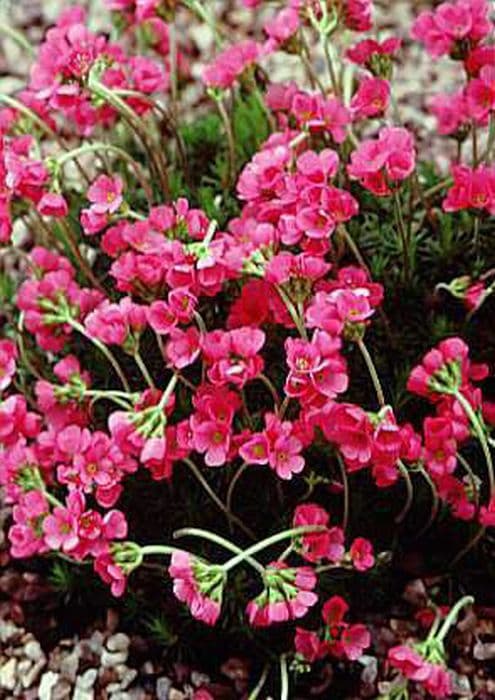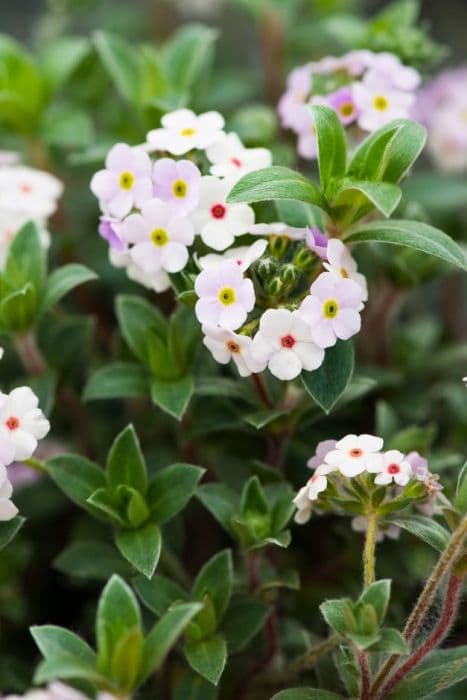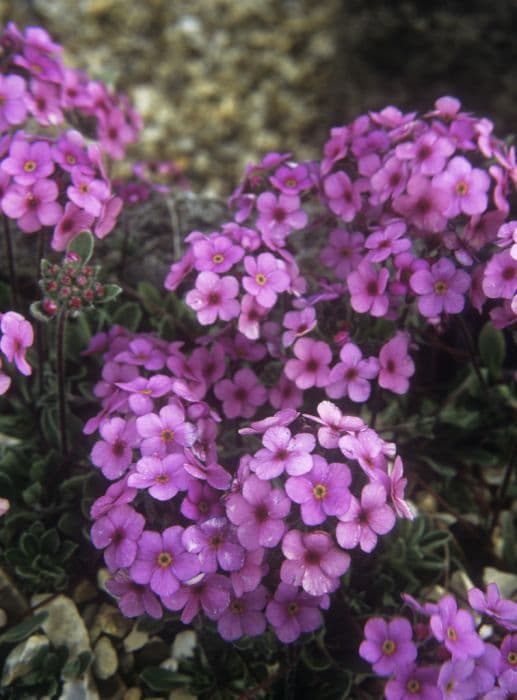Auricula Primula auricula 'Argus' (Au/a)

ABOUT
Primula auricula 'Argus,' commonly known as Auricula or Bear's Ear, is a unique flowering plant that possesses a distinct and ornamental appearance. It captivates with a rosette of fleshy, often spoon-shaped leaves that are typically green in color, with some varieties exhibiting a powdery coating that offers a grey or silvery look. The foliage forms a lush and dense ground cover, creating a verdant display of leaves. The striking feature of this plant is its flowers, which bloom in a remarkable array of colors from rich, deep purples to soft pastels, yellows, and even intense reds. Each gorgeous flower is characterized by a round shape with petals that may display a velvety texture. To add to the allure, the flowers sometimes exhibit a contrasting eye or center, adding depth and dimension to their appearance. This eye-catching center is often a different hue, enhancing the overall visual impact of the bloom. These vibrant flowers cluster at the top of sturdy stems, rising above the foliage to showcase their beauty. The beauty of the Auricula is further accentuated during its blooming season, when the clusters of vivid flowers present a dazzling display that is both eye-catching and delightful to behold. The combination of the attractive foliage and the dramatic blossoms makes Primula auricula 'Argus' a popular choice for garden enthusiasts who are looking to add a touch of elegance and colorful charm to their garden setting.
About this plant
 Names
NamesFamily
Primulaceae
Synonyms
Bear's Ear Auricula, Mountain Cowslip, Auricula Primrose
Common names
Primula auricula 'Argus'.
 Toxicity
ToxicityTo humans
The plant commonly known as Auricula is not considered highly toxic to humans. While it is not typically known for being poisonous, ingesting any part of the Primula auricula 'Argus' could potentially cause mild discomfort or an allergic reaction. Some individuals may experience symptoms such as nausea, vomiting, or diarrhea if ingested. Skin contact with the sap can sometimes lead to irritation or rash, particularly in those with sensitive skin or an existing allergy.
To pets
The Auricula, while not known to be severely toxic, can cause mild gastrointestinal upset in pets if ingested. Symptoms could include vomiting or diarrhea. As with many plants, the level of toxicity can vary, and while it is not considered a major toxin, it is still advisable to prevent pets from consuming the plant. If a pet does consume Auricula and exhibits adverse symptoms, it is best to consult with a veterinarian.
 Characteristics
CharacteristicsLife cycle
Perennials
Foliage type
Evergreen
Color of leaves
Green
Flower color
Varies
Height
6-8 inches (15-20 cm)
Spread
8-12 inches (20-30 cm)
Plant type
Herb
Hardiness zones
5
Native area
Europe
Benefits
 General Benefits
General Benefits- Ornamental Value: Adds color and visual interest to gardens with its striking flowers.
- Low Maintenance: Requires minimal care once established, making it suitable for gardeners of all skill levels.
- Attracts Pollinators: The flowers can attract bees and butterflies, supporting local ecosystems.
- Drought Tolerance: Once established, it can tolerate periods of dryness, reducing the need for frequent watering.
- Long Blooming: Offers a long flowering period in spring, providing extended enjoyment.
- Cold Hardy: Capable of withstanding colder temperatures, which means it can be grown in a variety of climates.
 Medical Properties
Medical PropertiesThis plant is not used for medical purposes.
 Air-purifying Qualities
Air-purifying QualitiesThis plant is not specifically known for air purifying qualities.
 Other Uses
Other Uses- As a collector's item: Auricula enthusiasts, also known as "auricula fanciers," prize 'Argus' for its unique coloration and form, often displaying them in traditional auricula theaters.
- In photography: The striking appearance of Auricula 'Argus' makes it an excellent subject for botanical photography, where its details and colors can be showcased.
- In educational gardens: Auriculas, including the 'Argus' variety, can be used in educational settings to illustrate plant hybridization and historical horticultural practices.
- Culinary garnish: Although typically not consumed, the flowers of Auricula 'Argus' may be used as a decorative, non-toxic garnish for special dishes in high-end culinary presentations.
- Ephemeral art: The colorful petals of the Auricula 'Argus' can be used in the creation of temporary natural art pieces, like mandalas or floral arrangements that are not intended to last.
- As a natural dye: The pigments in the flowers of Auricula 'Argus' can be used for dying fabrics or papers in small-scale artisanal crafts.
- Handcraft embellishment: Dried Auricula 'Argus' flowers can be applied to handcrafted items, such as decorative candles or homemade soaps, for an infusion of natural beauty.
- In miniature gardens: Due to their small size, Auricula 'Argus' can be included in miniature or fairy gardens, adding a touch of realism with live plants.
- As a component in potpourri: The dried petals of the Auricula 'Argus' may be included in potpourri mixes, contributing to the visual appeal and texture.
- In corsages and boutonnieres: Fresh Auricula 'Argus' flowers can be incorporated into these personal floral arrangements for special events like weddings, lending a unique and sophisticated touch.
Interesting Facts
 Feng Shui
Feng ShuiThe Auricula is not used in Feng Shui practice.
 Zodiac Sign Compitability
Zodiac Sign CompitabilityThe Auricula is not used in astrology practice.
 Plant Symbolism
Plant Symbolism- Unwavering Love: As a member of the primrose family, Primula auricula symbolizes eternal affection and deep love that endures through time.
- Patience: The auricula's ability to bloom in early spring after harsh winters reflects a message of patience and the endurance of beauty despite challenges.
- Hospitality: In traditional floriography, or the language of flowers, giving primroses like the auricula was a way to invite someone into your life, symbolizing openness and hospitality.
- Uniqueness: With its distinctive bear's ear-shaped leaves, the auricula signifies uniqueness and encourages the celebration of individuality in oneself and others.
 Water
WaterAuricula primroses need consistent moisture, so water them when the top inch of the soil feels dry, usually once a week. Use room temperature water and aim for the base of the plant to prevent water from sitting on the leaves and causing rot. In hot, dry weather, you may need to water them twice a week. During the winter, reduce watering to every couple of weeks, but don't let the soil completely dry out. Generally, give the auricula primroses about 1 gallon of water per square foot of soil every month during the growing season.
 Light
LightAuricula primroses thrive in partial shade, with some morning sun and protection from the strong afternoon sun. They do best in a spot that receives filtered sunlight or dappled shade, avoiding locations with full, direct sun which can scorch their leaves. A north-facing or east-facing site typically provides the ideal light conditions for auricula primroses.
 Temperature
TemperatureAuricula primroses prefer cool temperatures and enjoy a range between 50°F and 70°F. They can tolerate temperatures down to about 20°F and should be protected if the temperature dips below that. They will struggle in temperatures over 80°F and should be provided with shade and extra water to cope with the heat.
 Pruning
PruningPruning auricula primroses encourages new growth and helps to maintain their shape. Deadhead spent flowers regularly to promote further blooming and remove any dead or damaged leaves to prevent disease. The best time for pruning is immediately after flowering, typically in late spring or early summer.
 Cleaning
CleaningAs needed
 Soil
SoilAuricula prefers a well-draining soil mix with leaf mold and grit. Aim for a slightly alkaline pH between 6.5 and 7.5 for optimal growth.
 Repotting
RepottingAuriculas should be repotted every one to two years. This will replenish nutrients and prevent the plant from becoming root-bound.
 Humidity & Misting
Humidity & MistingAuriculas thrive in moderate humidity levels, around 50-60%. Avoid environments with very low or very high humidity to maintain plant health.
 Suitable locations
Suitable locationsIndoor
Place in bright, indirect light with cool temperatures.
Outdoor
Partial shade, sheltered from intense sun and wind.
Hardiness zone
4-8 USDA.
 Life cycle
Life cycleThe life cycle of Primula auricula 'Argus', commonly known as Auricula or Bear's Ear, begins with seed germination, which occurs in a moist, well-drained soil typically in early spring. Following germination, seedlings develop into a rosette of fleshy leaves, and within the first growing season, they establish a strong root system. In the subsequent spring, flowering stalks emerge from the center of the rosette, featuring the distinct, colorful blooms that range from yellow, red, purple to bicolored patterns. After pollination, often by bees or other insects, seeds develop in capsules and are eventually released when the capsules dry and open. The plant then enters a period of dormancy during late fall or winter, where it conserves energy. With favorable conditions in the next spring, the cycle resumes with the dormant plant sending up new growth and continuing its perennial life cycle.
 Propogation
PropogationPropogation time
Spring
The most popular method of propagating the Primula auricula 'Argus', commonly known as Auricula Primrose, is through division. This process is best done in late summer after the blooming period when plants are not actively growing. To propagate by division, gently lift the plant from the ground using a gardening fork, being careful not to damage the roots. Once lifted, shake off any excess soil and tease apart the individual crowns, each with their own root system. Each division should have at least one shoot and a portion of the root system. These divisions can then be replanted immediately, ensuring they are spaced about 6 to 8 inches (approximately 15 to 20 centimeters) apart to give them enough space to grow. Water the newly planted divisions well to help establish them.









